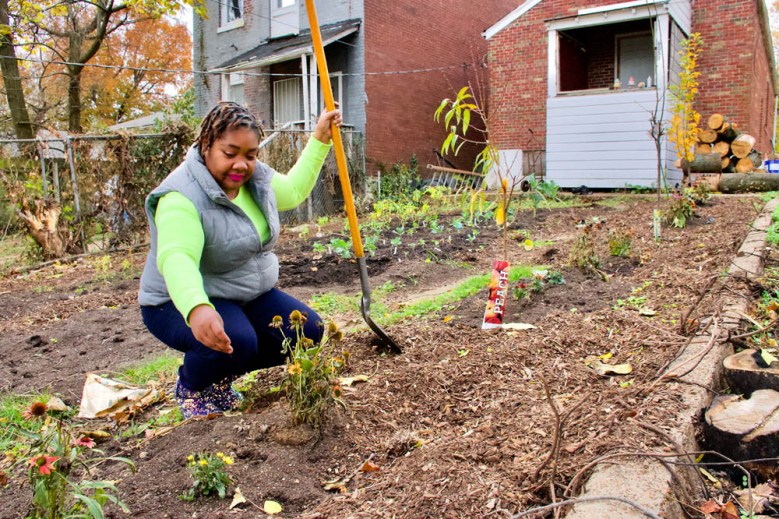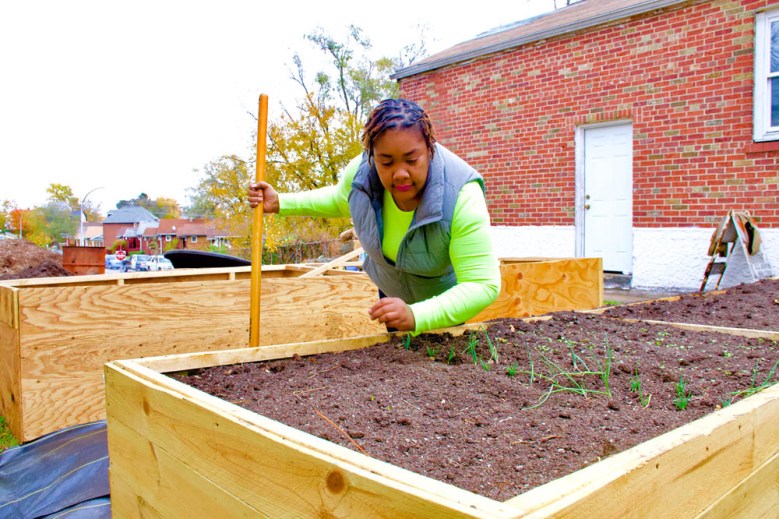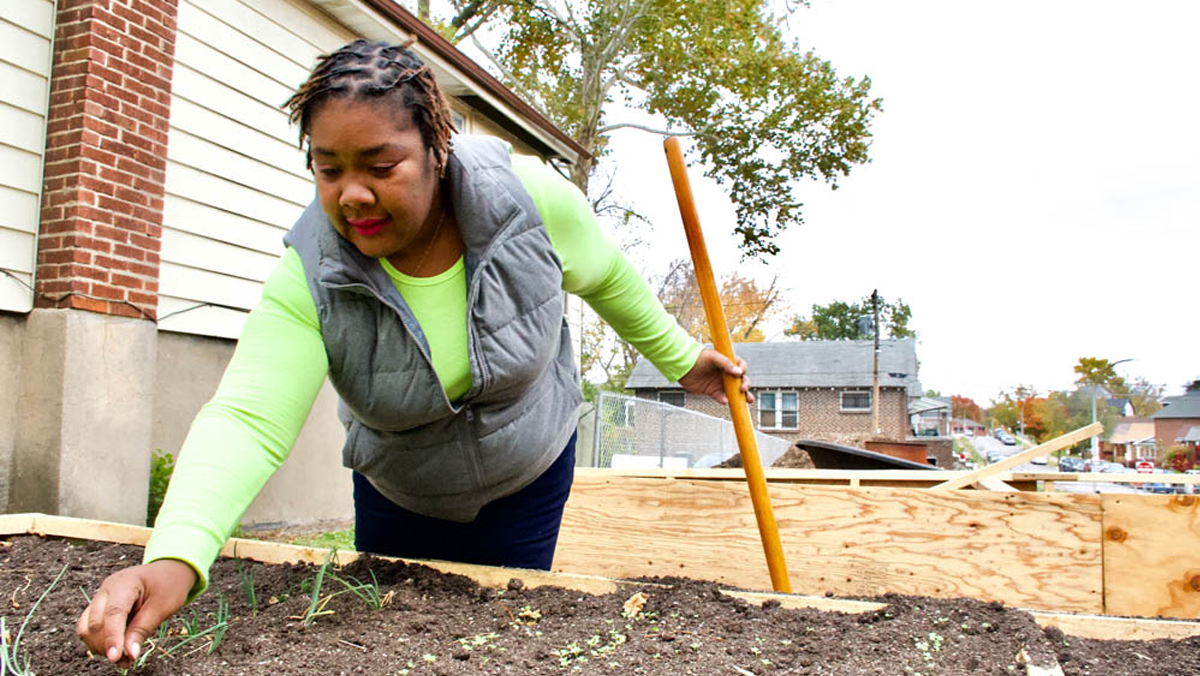Karen Robinson-Jacobs
During the pandemic, one in four Black Americans experienced food insecurity and activists say they want more members of the community to take an active role in solve the redlining-induced problem of “food apartheid.”
Before coronavirus shutdowns gave Mike Daniels an unexpected furlough, he hadn’t thought much about urban gardening, though he’d heard as a youngster about his great grandmother tilling the soil.
Yet weeks into the pandemic, the Lawton, Oklahoma former bowling alley attendant turned his backyard into a “mini-food forest,” feeding family and friends with ever-increasing varieties of produce including zucchini, tomatoes, peppers, and cucumbers. More recently, he conscripted a vacant third-acre lot owned by a friend near an area defined by the USDA as having low access to healthy food.
Daniels, who is African American, said he plans to convert the plot into a community garden by next spring “because of the passion behind it and [because of] the void in the community.”
“I feel like it’s necessary,” he added, excitement evident in his voice. “My plans are pretty much to feed the community.”
Just as the coronavirus laid bare inequities in health care decades in the making, it invigorated Blacks already in urban agriculture to expand and drew in new recruits, all aiming to create home-grown solutions to the redline-induced problem of limited access to healthy foods.
That keener focus on access, along with the broader racial reckoning wrought by the videotaped murder of George Floyd, has given food justice activists more ammunition. They are targeting not just the absence of retailers but also, and more pointedly, what they see as the systemic racism vexing bereft neighborhoods colloquially known as “food deserts” but which they call sites of “food apartheid.”
After decades of seeing tax credits thrown at corporate-owned grocery stores, both planters and activists are pushing for a more sustainable solution to healthy food access, one that casts people of color in directorship roles and leads to what activists call “food sovereignty.”
“Black people in urban areas are currently and increasingly interested in controlling our food system and resisting against the violence that our people experience through the corporate-controlled food system,” said Dara Cooper, co-founder of the National Black Food and Justice Alliance, a coalition focused on “creating a just food and land revolution.”
“I’m not saying we don’t want access to grocery stores, but my point is we want deeper solutions.”
When the pandemic exposed gaping holes in the nation’s food safety net, community organizations, nonprofits and the federal government scrambled to head off what loomed as a major food catastrophe.
The deadly virus shuttered businesses, slashing worker incomes. Schools across the nation, a source of food for millions of children, shut down.
In 2020, one in four Black residents across the U.S. experienced food insecurity — more than three times the rate for white households — according to Feeding America, the nation’s largest charitable hunger-relief organization.
The U.S. Department of Agriculture, which maintains a map of low-income census tracts in which there also is low access to healthy food, pegged the rate of food insecurity for Black households in 2020 at 21.7%, more than double the national average rate of 10.5%.
Charitable food systems responded by serving about 60 million people last year, an increase of 50% from 2019, according to Emily Engelhard, managing director of research for Feeding America. That includes many first-time food aid recipients.
The federal government responded by proffering billions. Spending on USDA’s food and nutrition assistance programs gained 30% in fiscal year 2020, (Oct. 1, 2019, to Sept. 30, 2020) to an inflation-adjusted record of $122.1 billion, reversing a six-year slide, a department report showed.
Rise of the Black farmer
On street corners and in vacant lots across the nation, one of the most visible self-help efforts can be seen in green shoots.
More than 25% of consumers surveyed in Packaged Facts’ 2020 national online consumer survey said they were planting a food garden because of the pandemic. That was a broad national survey that included adults of varying ages and ethnicities.

Many groups looking specifically to help Black Americans get a shovel in the ground also say they have seen exponential growth during the pandemic.
Bryan Ibrafall Wright, founder of the Black Urban Gardening Society based in Oklahoma City, said his group, which focuses on “sustainability in the Black community” has had “easily” over 30,000 membership inquiries since the beginning of the pandemic. The four-year-old group has accepted about 5,000 new members.
“Many of our members are in low-income communities and they look to agriculture as a means to supplement their diets, their incomes as well,” he said.
Leah Penniman, co-director of Soul Fire in the City, an urban ag program in the Albany and Troy areas in New York State saw a more than 5-fold increase in participation in that program since the pandemic’s onset.
Initially, “we went from 10 families [per] year in the program to 50 families,” Penniman said, noting that the backyard urban gardening program provides participants with raised beds, soil, and supplies, and helps “teach folks to grow their own food.”
The number of families recently has grown to 70. All are people of color and have low incomes. About 85% are Black, including African Americans, she said.
“Since Black folks were and are disproportionately impacted by COVID, it makes sense to see an increase in urban gardening participation at this time,” she said.
Of course, Blacks have been linked to American soil since before a patch of disparate communities became states united. Even after the post-slavery U.S. government went back on its promise of 40 acres and a mule, African Americans have tried to coax a livelihood from the dirt.
In 2017, there were 35,470 farms in the U.S. with Black or African American producers, less than 2% of all U.S. farms, according to the most recent census of agriculture.
It’s also a fraction of the historical census of Black farmers.
In 1920, of the 6.5 million U.S. farm operators, 925,708 were Black, compared with 5.5 million Whites, according to the USDA.
African American participation has declined steadily, as Black farmers faced not only the vagaries of weather but also, many say, discrimination from the USDA.
“Statistically, Black farmers are still underrepresented and under-supported in comparison to their White counterparts,” said LeeAnn C. Morrissette of the National Black Food & Justice Alliance.
Claims against the U.S. government got a very public airing during a class-action lawsuit, known as Pigford, that alleged that USDA discriminated against African Americans who applied for farm loans or other farm benefits between Jan. 1, 1981, and Dec. 31, 1996.
In 1999, that case led to what was described as the largest civil rights class action settlement in U.S. history, but many Black farmers still had trouble accessing settlement benefits, according to media reports.
Meanwhile, billions of dollars in debt forgiveness for farmers of color were included as part of pandemic relief. But a judge has put the money on hold following lawsuits filed by White farmers claiming that the program amounts to reverse discrimination, according to John Wesley Boyd Jr., president of the National Black Farmer’s Association. In a segment on Good Morning America, he countered: “they really should be ashamed of themselves … they don’t know what discrimination is.”
“Black people have been slaves,” he said. “We’ve been sharecroppers and survived through horrific laws of Jim Crow. We had to go through the back door … and things of this nature. And we’ve been discriminated against, from a systematic standpoint, at the United States Department of Agriculture, and it’s time for those things to change.”
Food deserts to food apartheid
The sense that the harm done to people of color, both food producers and consumers, is systematic and not just happenstance or naturally occurring, is behind not only the ire of Black farmers but also of activists working to change the food access narrative, beginning with a change of names.
A review of “food deserts” on the Centers for Disease Control and Prevention website noted the earliest use of the term was said to be in Scotland in the early 1990s, where it was used to describe limited access to an affordable and healthy diet.
The term caught on in the U.S. and became shorthand for low-income urban areas, with high concentrations of people of color and the distinct dearth of traditional grocers.
The USDA has changed the name of its former “Food Desert Locator” map to the Food Access Research Atlas. It has not officially used the term “food desert” since 2013, pivoting to the more clinical “low-income and low-access” to designate areas with limited access to healthy food because it “more accurately reflects what is statistically measured in the Food Access Research Atlas,” a USDA spokeswoman said.
That verbiage, activists say, omits what they see as a crucial feature of the corporate and political policies that lead to the current landscape – racism.

“In food apartheid, I also use the term food redlining and … Jim Crow, policies are explicitly racialized and explicitly anti-Black, right?” noted Cooper of the Food and Justice Alliance. “Apartheid conjures a more accurate picture of the disparities that we’re addressing, and it also points to the intentionality behind the conditions that Black communities are experiencing within the food systems, the mainstream corporate-controlled food system.
“The term ‘food deserts’ ended up erasing the particular anti-Blackness behind what was happening with the corporate controlled system,” she said. “And a lot of the solutions that followed were based on a flawed analysis.”
Cooper said she hopes using terms like food apartheid and food redlining “draws our attention to the root causes, and [gets] us to think deeper about the violent separation of Black people from the means to feed our community.
“It’s not just about access to a corporate-controlled system,” she added. “That’s not what we’re asking for. We’re working towards actually [controlling] the means to feed our people and for our own solutions that we’ve always been inside of.”
Brian Lang is director of healthy food access programs at The Food Trust, a Philadelphia-based nonprofit whose mission is to “ensure that everyone has access to affordable, nutritious food and information to make healthy decisions.”
He sees the terminology used to describe unequal access as “incredibly important” and prefers the term “food redlining,” a nod to the decades-long denial of loans in areas with high concentrations of low-income people of color.
“Deserts are naturally occurring phenomenon, right, that just kind of happen in the world because of a set of environmental conditions,” he said. “And so, in that sense, using the analogy of a desert to talk about communities, in cities and in rural areas that didn’t have grocery stores didn’t feel right to me, because what we saw in those places was the result of market forces, as well as public policy choices which are not the same thing as weather patterns.”
When accused of abandoning low-income areas, grocers, who operate on notoriously thin margins, routinely point to profit and loss statements that guide them to open in areas with higher incomes and steady foot traffic.
One of the largest food trade groups is FMI, the Food Industry Association, which describes itself as the “champion for feeding families and enriching lives with nutritious, safe and affordable food at retail.”
Spokeswoman Heather Garlich said in a statement “grocers are open to feedback and conversations to better meet the needs of the neighborhoods in which they serve,” adding, “our industry embraces community in every way possible.”
She did not answer questions about the neighborhoods grocers abandon.
That corporate abnegation has led community members to cultivate their own solutions, with varying degrees of government assistance and varying degrees of success.
In November, Maine voters backed the “Right to Food” measure, an amendment to the state’s constitution that gives state residents an “unalienable right” to grow, raise, produce, and consume food of their choice.
The move was seen as a major step in the broader food sovereignty movement in a state that’s 94% White and where 60% of the population lives in areas considered rural.
Black farmers forge ahead
In urban areas, where backyards may be small and vacant lots plentiful, a fresh crop of gardeners and farmers has taken root.
Before the pandemic hit, Jamie Edwards took a $2,000 bonus she earned while working at Amazon and plowed it into a small garden on land leased from St. Louis on the city’s north side, just up the road from a pawn shop, an auto parts store and an area deemed “low access” by the USDA. The money went to pay for compost, eight cubic yards worth, woven fabric for weed control and other supplies.
“The area is not the safest area …you have all kinds of things going on around you,” she said of the neighborhood marked by boarded-up homes and some residents whose incomes dip below the poverty threshold. “But this is where the need for food justice is going on. So that’s why we chose [that] location.”
Following a series of mishaps – from lost paperwork in the St. Louis office tasked with administering the lease to having the young garden accidentally demolished twice – Edwards opted to move her efforts to another city-owned lot about five miles away.
Across the street, one of at least four vacant lots on the block sports a bumper crop of discarded furniture. Edwards is growing peach and pear trees and hopes to add chickens.
Her nonprofit, City Blossoms, offered to buy the new lot but was rebuffed because Edwards is not a city of St. Louis resident.
Laura Costello, director of real estate for the St. Louis Development Corp. confirmed that policy is to sell to local residents.
Edwards, who lives just outside the city limits but has family in the neighborhood, said she remains committed to the gardening project but has found the process of getting up and running more hurdle-filled than she’d hoped.
“Due to the pandemic, wood prices are astronomical,” she said, doing mental calculations on her $6,400 in costs thus far. “Again, another expense the everyday person that’s living in the city can’t afford. If they can’t afford the food, how do you think they’re going to afford the stuff to put the garden together?”
Kimberly Calvin, a city council member in San Bernardino, California, recognized the growing role of community gardens both as an elected official and as a practitioner. She founded a nonprofit called Akoma Unity Center and with volunteers and youth from the center, operates the Shirrell’s Community Garden in San Bernardino.
“All over the city you see community gardens that are growing in vacant spaces, and the interest and the concern for folks who were already doing this type of work, now have a larger platform in order to get the rest of the community to understand — look, we have to be sustainable, we have to be resilient in our own resources,” Calvin said.
About 10 miles north of Jamie Edwards’ produce plot, in St. Louis’ Spanish Lake neighborhood, Janett Lewis recently was celebrating a win for her Rustic Roots, a community garden Lewis said sprouted in place of a former “nuisance” property.
Lewis had been turned down earlier this year for a zoning change that would allow farming in the urban neighborhood. Now, with backing from her local councilwoman, Lewis is hopeful the logjam will be busted.
That assistance aside, she too expressed concern about the number of stumbling blocks placed between hope and harvest.
“Do I feel things could be improved in the government in general? Yes. I think legislation can be introduced that lessens restrictions on urban farmers and community gardens in [low-income areas]. If food access is an issue, we should be doing everything we can to support growers.”
Tosha Phonix of St.Louis-based EVOLVE, a food justice advocacy group, would like to see more retailers purchase produce from Black urban farmers to support those businesses and foster more of a connection between residents and growers. It’s an effort that’s yet to bear fruit.
Penniman of Soul Fire Farm sees community plantings as a way to “fill gaps in food access while bolstering longer-term food sovereignty.”
“Before, during, and after the pandemic, food apartheid continues and will continue to disproportionately impact BIPOC communities, who now also face higher vulnerability to COVID-19 due to such factors as shared housing, lack of access to health care, environmental racism, job layoffs, immigration status, employment in the wage economy without worker protections, and more,” Penniman said. “We acknowledge that provision gardens are one strategy to strengthen community food sovereignty and [they] must be accompanied by systems and policy change.”
Karen Robinson-Jacobs is a Report for America corps member with The St. Louis American / Type Investigations in St Louis, MO, covering business. This story is part of ‘Barren Mile: COVID-19 and the fight against food apartheid,” the result of a Report for America initiative that brought Black-owned newsrooms from New York, Georgia, Missouri, and California together to look at how COVID-19 impacted food insecurity in their communities.
Breanna Reeves, a California-based reporter with Black Voice News and an RFA corps member, contributed to this story.



